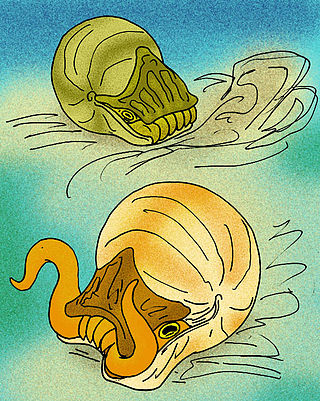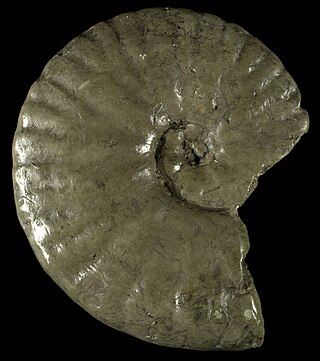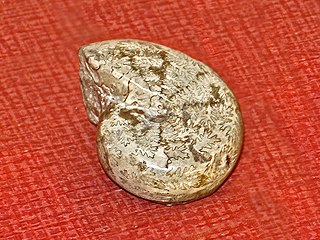Anaklinoceras is a genus of extinct heteromorph ammonite cephalopod that lived in marine environments in what is now Western North America during the Campanian division of the Cretaceous period. Their shells were very similar to the related ammonites of the genus Ainoceras, where the young ammonite's shell coiled helically, and upon reaching adulthood, the youngest coil arched over the older coils.
Arieticeras is an extinct genus of cephalopod belonging to the Ammonite subclass.

Arcestes is a genus of extinct ceratitid ammonites found in Triassic-aged marine strata.

Androgynoceras is an extinct genus of cephalopod belonging to the ammonite subclass. The Green Ammonite Beds of the Dorset Coast are named after Androgynoceras lataecosta which has chambers filled with green calcite.
Angulaticeras is an extinct genus of cephalopod belonging to the ammonite subclass.
Arcthoplites is an extinct genus of cephalopod belonging to the ammonite subclass.
Austrotrachyceras is a genus of ammonite cephalopod, belonging to the order Ceratitida.
Pseudotoites is an extinct genus from a well-known class of fossil cephalopods, the ammonites. It lived during the Middle Jurassic.

Oppelia is a haploceratoid ammonite and type genus for the Oppeliidae that lived during the Middle Jurassic. Shells of Oppelia are involute with a small to moderate size umbilicus, bluntly rounded to sharp venter, and deeply impressed dorsum. Sides are generally smooth but may be variously ribbed on the outer flanks. Similar and related genera include Oxycerites and Oecotraustes.

Phylloceras is an extinct genus of ammonoid cephalopods belonging to the family Phylloceratidae. These nektonic carnivores lived from Early Jurassic to Late Cretaceous.

Peroniceras is an ammonite belonging to the Ammonitida family Collignoniceratidae.
Kilianella is a genus of the ammonite family Neocomitidae. The shell of Kilianella is evolute with a slightly grooved venter and covered by strong, gently flexious, single or bifurcating ribs.
Neophylloceras is an extinct genus of cephalopod belonging to the Ammonite subclass.

Waehneroceras is an extinct genus of cephalopod belonging to the Ammonite subclass.
Phricodoceras is an extinct genus of cephalopod belonging to the Ammonite subclass.

Metoioceras is an extinct genus of cephalopod belonging to the Ammonite subclass which lived during the Cenomanian.

Ludwigia is an extinct genus of ammonites in the family Graphoceratidae, which lived during the Middle Jurassic.
Daxatina is a fossil ammonoid cephalopod included in the trachyceratid family of the order Ceratitida that lived during the middle of the Triassic.

Baluchicardia is an extinct genus of fossil saltwater clams in the family Carditidae. These clams were facultatively mobile infaunal suspension feeders.

Cladiscites is an extinct genus of cephalopods in the ammonoid order Ceratitida. These nektonic carnivores lived during the Triassic, from Carnian to Rhaetian age.










